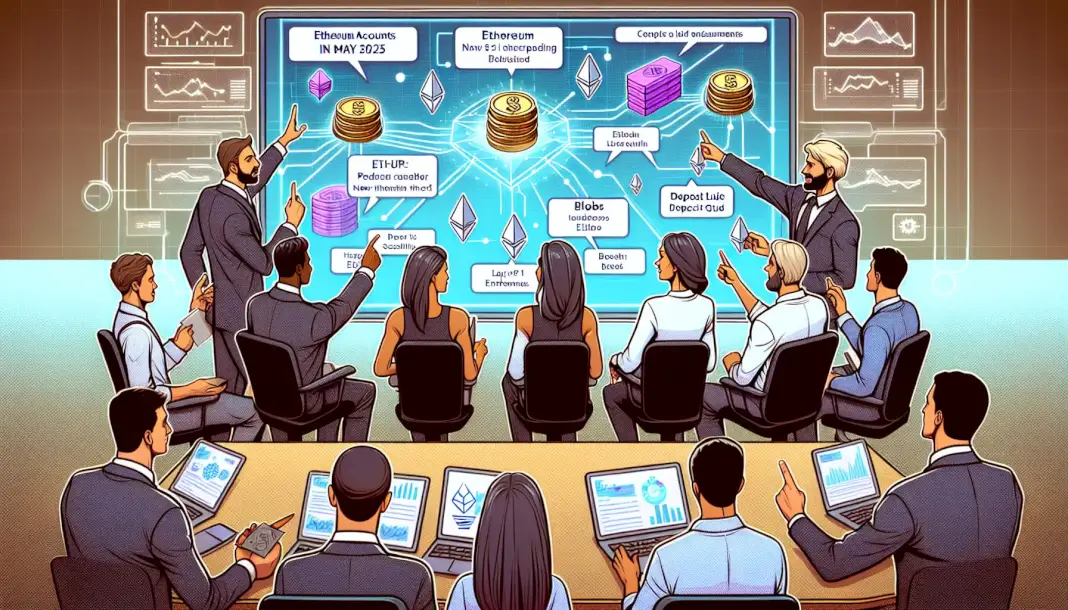KEY TAKEAWAYS
- The Ethereum network will undergo the Pectra upgrade on May 07, 2025, enhancing accounts and validator experiences.
- EIP-7702 introduces account abstraction, allowing EOAs to incorporate smart contract functionalities.
- The upgrade doubles Ethereum’s blob throughput, reducing L1 fees for L2s and improving transaction affordability.
- Node operators must update their software to avoid disconnection and potential network forks.
The Ethereum network is poised for a significant enhancement with the upcoming Pectra upgrade, scheduled to activate on the mainnet on May 07, 2025, at epoch 364032 (10:05:11 UTC). This upgrade follows the Dencun update from last year and introduces several key features aimed at augmenting Ethereum accounts, improving the validator experience, and supporting Layer 2 (L2) scaling. The full details of the upgrade can be explored here.
Enhancements to Ethereum Accounts and Validator Experience
One of the major components of the Pectra upgrade is EIP-7702, which represents a significant step towards account abstraction. This enhancement allows users to augment their Externally Owned Accounts (EOAs) with smart contract functionality, combining the simplicity of EOAs with the programmability of contract-based accounts. This hybrid approach enables wallets to support various functionalities such as batching, sponsorship, and authentication logic.
Additionally, the upgrade introduces three new Ethereum Improvement Proposals (EIPs) aimed at enhancing the validator experience. EIP-7251 increases the maximum balance on which a validator can receive rewards from 32 ETH to 2048 ETH, allowing for reward compounding and reducing network bandwidth requirements. EIP-7002 introduces execution layer triggerable withdrawals, enabling Ethereum addresses set as withdrawal credentials to initiate exits, thereby reducing trust assumptions in delegation settings. Lastly, EIP-6110 reduces the delay between validator deposits and their addition to the deposit queue from around 9 hours to approximately 13 minutes.
Doubling Ethereum’s Blob Throughput
The Pectra upgrade also includes EIP-7691, which doubles Ethereum’s blob throughput. Blobs, introduced in the Dencun upgrade, are ephemeral data storage used by L2s to submit compressed transaction data and proofs to Ethereum’s Layer 1 (L1). Since their introduction, blobs have significantly reduced L1 fees for L2s, making transactions more affordable. With EIP-7691, the average number of blobs per block will increase from 3 to 6, with a maximum of 9 during high demand periods.
To manage the increased bandwidth requirements, Pectra introduces EIP-7623, which caps the worst-case size of a block. This change is part of a broader strategy to scale Ethereum’s data throughput without a corresponding rise in bandwidth requirements, as outlined by the Ethereum Foundation Research team.
Node operators are required to manually update their software to support the protocol changes introduced by the Pectra upgrade. Failure to do so will result in disconnection from upgraded peers, potentially leading to a network fork. For those interested in observing the upgrade, an online viewing party will be available.
Why This Matters: Impact, Industry Trends & Expert Insights
The Ethereum network is set to undergo a major transformation with the Pectra upgrade, enhancing mainnet functionality and introducing key features like account abstraction and improved validator experience. This upgrade is scheduled for May 07, 2025, and aims to bolster Ethereum’s scalability and usability.
Recent industry reports indicate that Ethereum’s Layer 2 scaling ecosystem has significantly advanced, focusing on reducing fees and increasing throughput. The Pectra upgrade’s enhancements, such as doubling Ethereum’s blob throughput, align with these trends by supporting Layer 2 scaling and reducing transaction costs, enhancing the network’s overall efficiency.
As per insights from a Coinspeaker report, the Pectra upgrade is seen as a pivotal enhancement for Ethereum, combining protocol improvements to boost user experience and network efficiency. This supports the potential for increased on-chain activity and institutional participation, reflecting the upgrade’s strategic importance in maintaining Ethereum’s competitive edge.
Explore More News:
Disclaimer: The views expressed in this article are those of the authors and do not necessarily reflect the official policy of CoinsHolder. Content, including that generated with the help of AI, is for informational purposes only and is not intended as legal, financial, or professional advice. Readers should do their research before taking any actions related to the company and carry full responsibility for their decisions.

